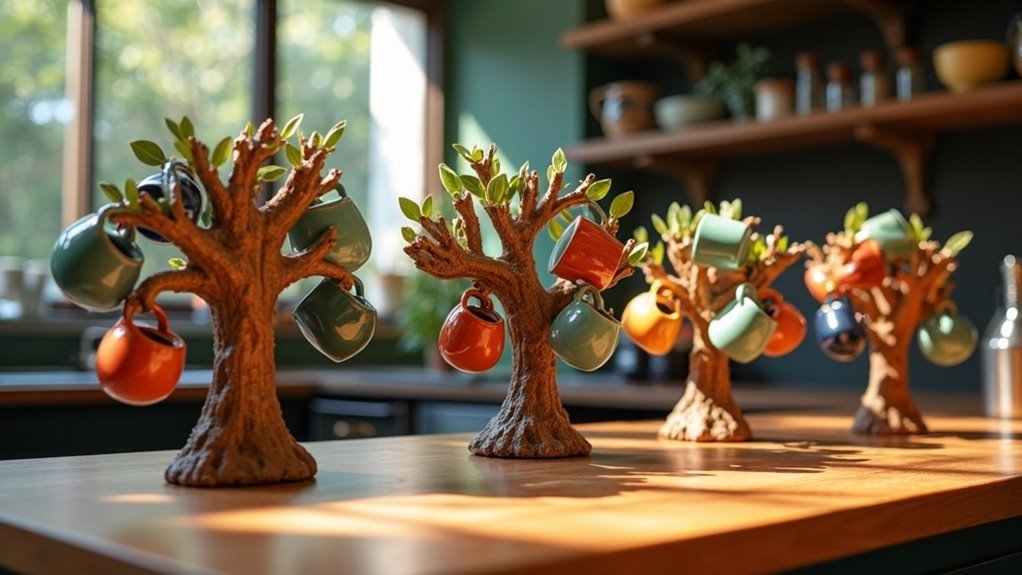Mundo Novo coffee is a hybrid varietal resulting from the crossbreeding of Red Bourbon and Typica, developed in Brazil during the 1940s. It’s prized for its adaptability, high yield potential, and complex flavor profile, featuring notes of hazelnut and chocolate with low to medium acidity. Grown in regions like Minas Gerais and São Paulo, it thrives in nutrient-rich soils and high altitudes. Explore further to uncover more about its unique cultivation practices, flavor nuances, and global influences on the coffee industry.
Key Takeaways
- Mundo Novo is a coffee varietal that originated from the hybridization of Red Bourbon and Typica in Brazil during the 1940s.
- It offers a rich flavor profile, featuring delightful notes of hazelnut, chocolate, and caramel sweetness, making it a favorite among coffee lovers.
- This varietal flourishes in nutrient-dense soils and elevated altitudes, predominantly found in regions such as Minas Gerais, São Paulo, and Paraná.
- Mundo Novo is moderately resistant to diseases, notably coffee leaf rust, which positions it as a sustainable option for farmers.
- Its genetic makeup has significantly influenced other popular coffee varieties, contributing to enhanced quality and resilience in the world of coffee cultivation.
The Hybridization and Development of Mundo Novo
When you explore the origins of the Mundo Novo coffee varietal, you’ll discover it emerged from the natural hybridization of the Red Bourbon and Typica (Sumatra variety) in 1943, specifically in Mineiros do Tietê, São Paulo, Brazil.
The Instituto Agronômico de Campinas meticulously selected the first seeds between 1943 and 1952 in an area known as Novo Mundo.
This coffee varietal gained traction among Brazilian farmers due to its remarkable adaptability and high yield potential. Its tall growth habit and vigorous production greatly influenced coffee agriculture in Brazil, leading to its stabilization and commercial distribution beginning in 1952.
Mundo Novo’s Potential for Specialty Coffee
Mundo Novo’s complex flavor profile presents a unique opportunity for exploration in specialty coffee, especially with its rich notes of hazelnut and chocolate.
To fully unlock its potential, it’s crucial to implement effective disease management strategies, as its susceptibility to problems like coffee leaf rust can jeopardize both yield and quality.
Flavor Complexity Exploration
Mundo Novo coffee, often less celebrated than its more renowned counterparts, presents a unique flavor complexity that warrants recognition in the specialty coffee realm.
Its flavor profile features rich notes of hazelnut, chocolate, and fruit, all enveloped in a smooth mouthfeel and low to medium acidity, making it appealing to a wide array of coffee enthusiasts.
Thriving in high-altitude coffee-growing regions, particularly in Brazil, Mundo Novo enhances its cup quality while offering farmers the potential for high yields, resulting in exceptional coffee production.
With its distinct characteristics, Mundo Novo stands out as a remarkable contender among Brazilian coffee varieties, inviting coffee lovers to explore its unique offerings.
Disease Management Strategies
Effective disease management is crucial for cultivating Mundo Novo coffee, particularly due to its vulnerability to coffee leaf rust and coffee berry disease.
To boost your chances of growing healthy coffee plants, consider these proactive strategies:
- Maintain optimal soil conditions to promote robust plant health.
- Utilize single-stem pruning to enhance airflow around the plants, thereby lowering the risk of disease.
- Keep a close watch for early indicators of plant diseases, allowing for prompt intervention when necessary.
- Explore resilient coffee strains and adopt integrated pest management practices to enhance disease resistance in Mundo Novo and other coffee varieties.
Flavor Profile of Mundo Novo Coffee
When exploring the flavor profile of Mundo Novo coffee, you’ll encounter a rich and balanced experience that appeals to diverse palates.
This coffee varietal boasts low acidity, making it approachable for many coffee enthusiasts. You’ll notice prominent nutty flavors, such as hazelnut and almond, alongside chocolatey tones reminiscent of milk chocolate and cocoa.
Mundo Novo coffee offers low acidity and a delightful blend of nutty and chocolatey flavors, perfect for any coffee lover.
The caramel sweetness adds significant complexity, often likened to brown sugar or honey. Occasionally, subtle fruity undertones like peach or apricot emerge, enriching the overall cup.
With its full body, Mundo Novo is particularly well-suited for espresso and blended coffee applications, enhancing its versatility in the coffee world.
What Makes Mundo Novo Coffee Growing Regions Unique?
Mundo Novo coffee’s unique growing regions significantly shape its quality and flavor profile, influenced by various environmental factors.
- The nutrient-rich soils, including volcanic and red clay, promote robust growth.
- Brazil’s key coffee-growing regions—Minas Gerais, São Paulo, and Paraná—provide optimal climate conditions for cultivation.
- Growing at high altitudes, particularly in Peru above 1,500 meters, enhances the fruity and caramel notes in its flavor profile.
- Mundo Novo’s adaptability to various environments makes it an important varietal in Brazil and across South America.
These factors come together to deliver a distinctive coffee experience that reflects the terroir of its origins.
Characteristics in the Field
In the field, you’ll notice that Mundo Novo coffee plants exhibit a tall stature and vigorous growth, greatly enhancing their yield potential.
However, their susceptibility to diseases like coffee leaf rust and nematodes necessitates robust management strategies to ensure successful cultivation.
Understanding these growth habits alongside disease factors is essential for optimizing your coffee production.
Growth Habit and Yield
Although Mundo Novo coffee plants are recognized for their robust growth, they display a tall growth habit that significantly boosts their productivity in cultivation.
These plants are adaptable and can thrive at altitudes ranging from 600 to 1,500 meters. Key factors that influence their yield include:
- They mature late, with fruit production beginning in the third year.
- A recommended planting density of 3,000 to 4,000 plants per hectare.
- The application of single-stem pruning to promote optimal growth.
- Their susceptibility to diseases like coffee leaf rust, which can impact overall productivity.
Disease Susceptibility Factors
While the robust growth habit of Mundo Novo coffee plants offers many advantages, their disease susceptibility presents significant challenges for growers. Notably, Mundo Novo exhibits low resistance to coffee leaf rust and is highly vulnerable to coffee berry disease, which can adversely affect yield and quality.
Additionally, nematodes pose a threat to plant health, potentially leading to wilting or death if not effectively managed. Despite their sturdy root system and adaptability, the tall growth habit complicates disease management.
As plant diseases continue to evolve, ongoing research is crucial to develop more resilient coffee strains that can address these susceptibility issues.
Breeding Contributions and Innovations
Mundo Novo’s genetic contributions have significantly influenced the coffee varietals landscape, enhancing both quality and resilience in the coffee industry.
Its breeding innovations have led to the development of notable varietals, including:
- Acaia: Renowned for its large beans and exceptional cup quality, Acaia also exhibits moderate resistance to coffee leaf rust.
- Rubi: This varietal combines the vigor of Mundo Novo with the compact stature of Catuai, resulting in high yields and strong disease resistance.
- Catuai: A hybrid that benefits from the adaptability of Mundo Novo, making it a versatile choice for growers.
- Flavor Profiles: Acaia is celebrated for its sweet notes, while Rubi offers a low-acidity cup, showcasing Mundo Novo’s diverse impact on coffee genetics and cultivation practices.
Global Influence and Future Outlook
As coffee enthusiasts and producers alike recognize the significance of Mundo Novo, its global influence extends beyond its native Brazil, adapting well to diverse growing conditions across Peru, Colombia, Mexico, and parts of Africa.
While its tall stature and susceptibility to coffee leaf rust limit broader adoption, Mundo Novo’s adaptability and reliable yield keep it relevant in the global coffee supply.
Breeding programs focus on enhancing disease resistance and sustainability, ensuring its commercial importance in both specialty and mainstream markets.
This ongoing research could secure Mundo Novo’s position, delighting coffee lovers and supporting the ever-evolving coffee supply chain.
Related Varieties
Though often overshadowed by more prominent varietals, related varieties to Mundo Novo exhibit unique characteristics that contribute to the rich and diverse world of coffee. Understanding these connections can enhance your appreciation for coffee’s complexity:
Related varieties to Mundo Novo offer unique characteristics that enrich the diverse world of coffee, enhancing your appreciation for its complexity.
- Catuai: A high-yield Arabica cultivar that combines the traits of Mundo Novo and Caturra, Catuai is known for its sweet, Bourbon-like flavors, making it a favorite among coffee enthusiasts.
- Pacamara: This hybrid of Pacas and Maragogipe shares genetic similarities with Mundo Novo, and is celebrated for its exceptional cup quality. However, it’s also highly susceptible to coffee leaf rust, requiring careful cultivation.
- Acaia: Developed from Mundo Novo in 1977, Acaia offers enhanced bean size and cup quality, along with moderate resistance to rust, making it a valuable addition to coffee farming.
- Rubi: By combining the vigor of Mundo Novo with the compact stature of Catuai, Rubi produces a sweet, low-acidity cup that’s particularly well-suited for espresso preparations.
Exploring these related varieties can deepen your understanding and appreciation of the diverse flavors and profiles that coffee has to offer.








